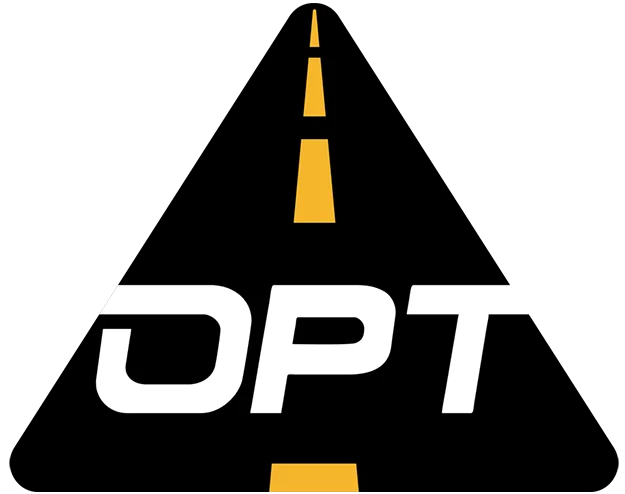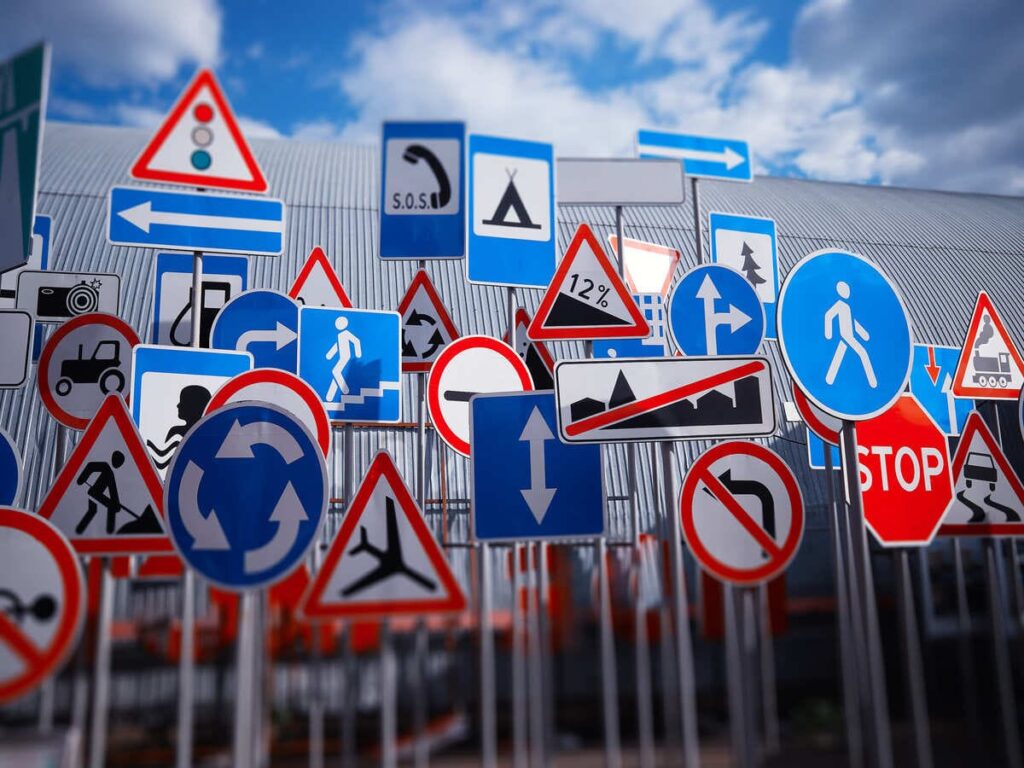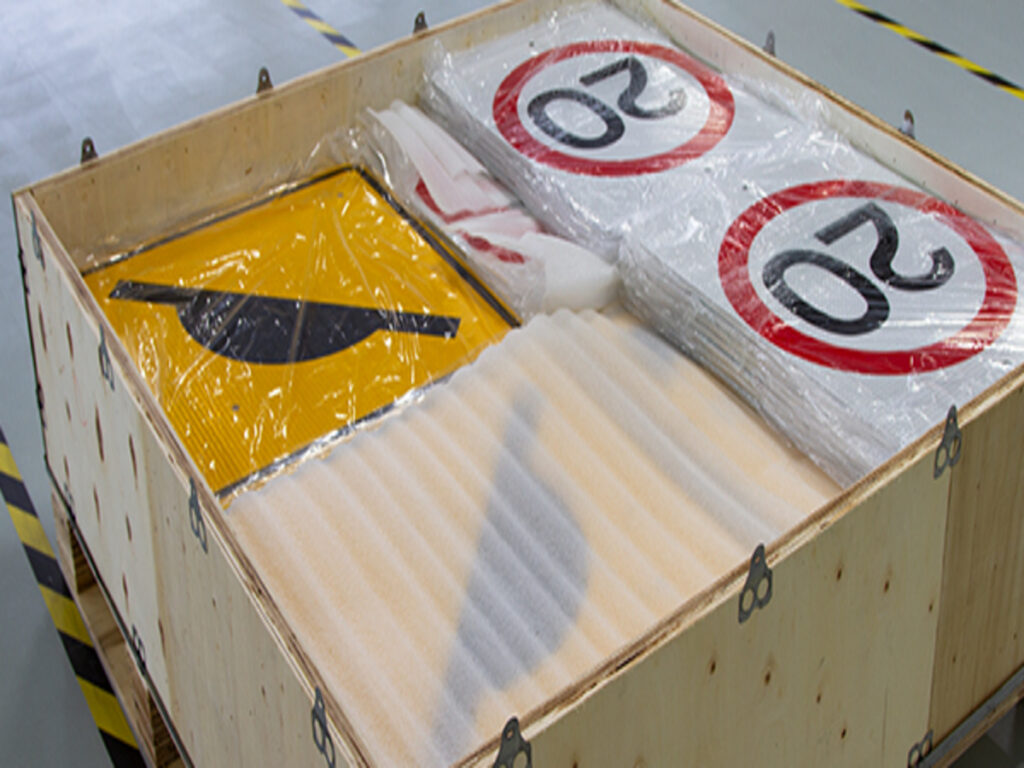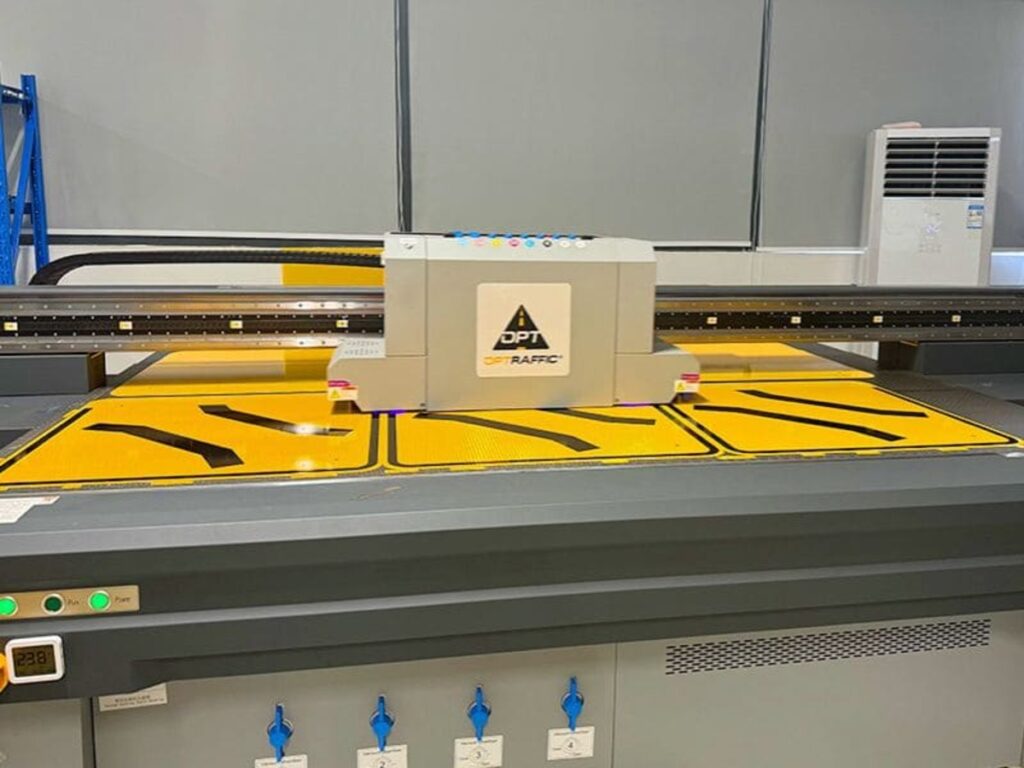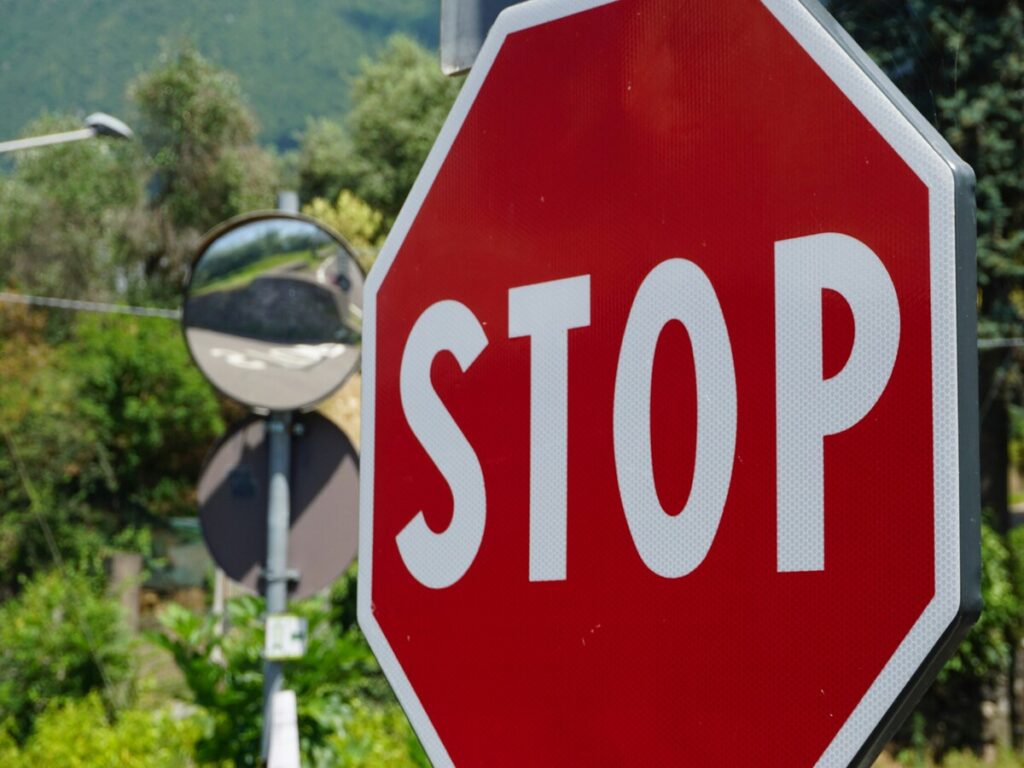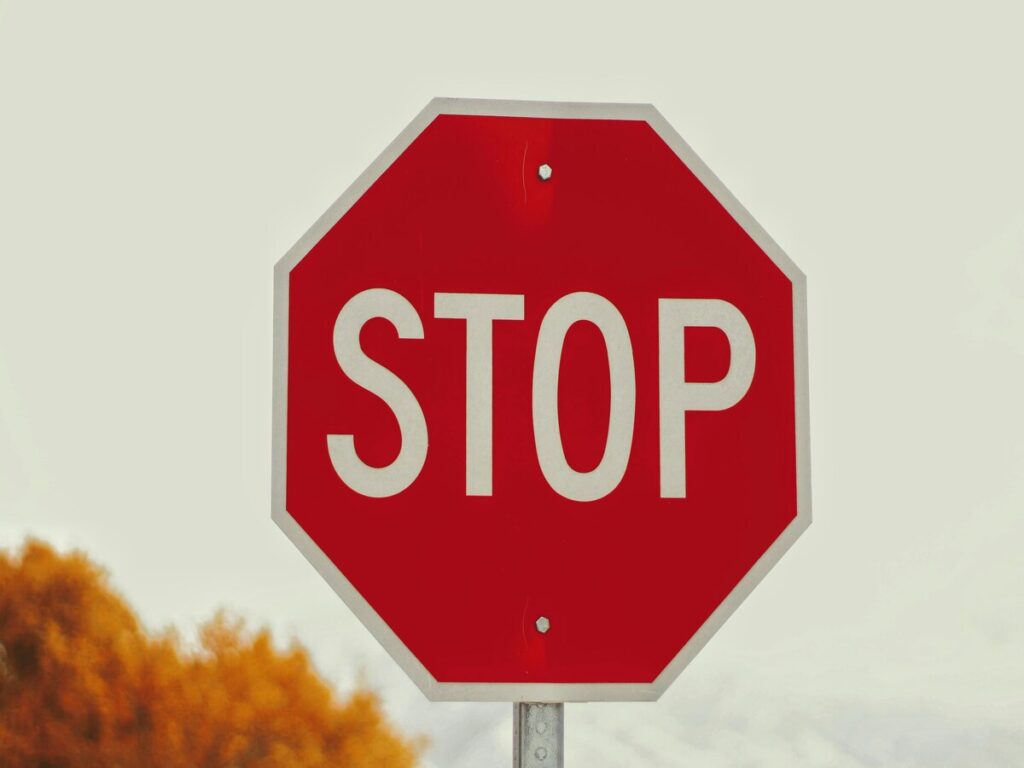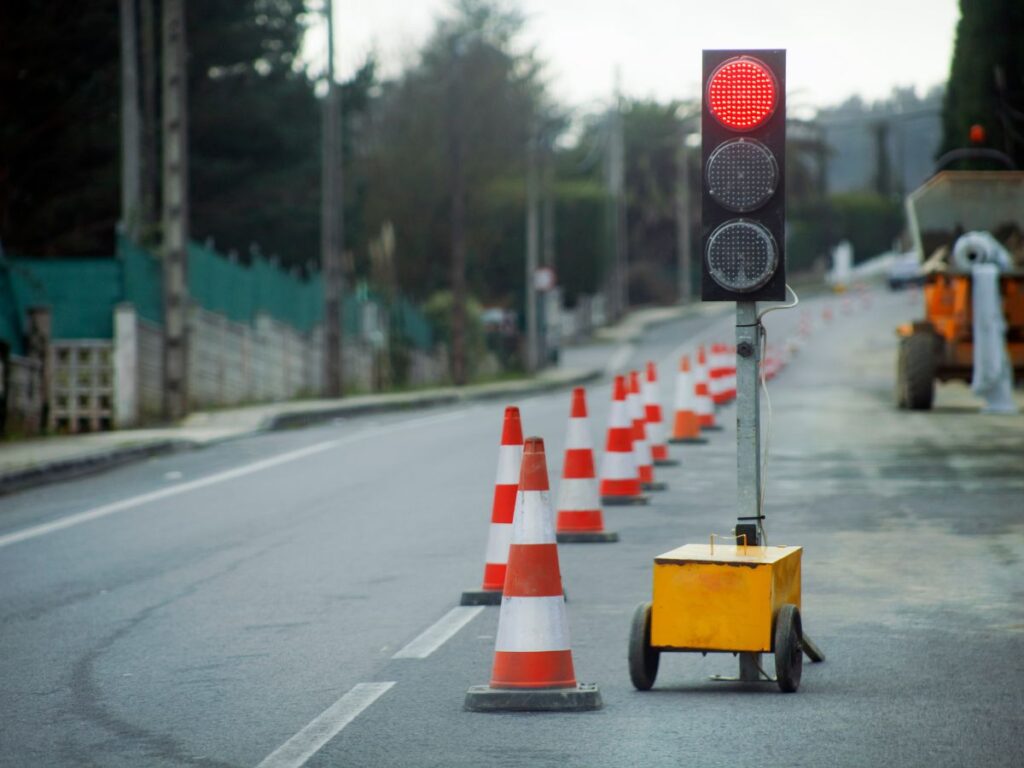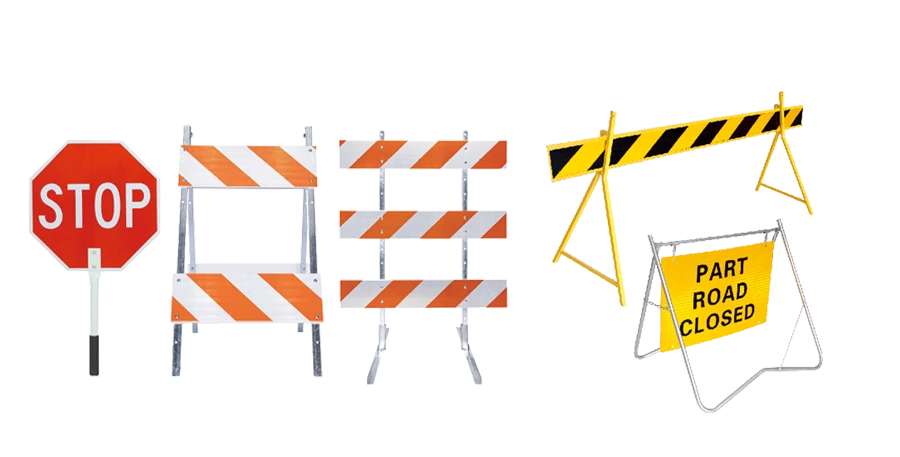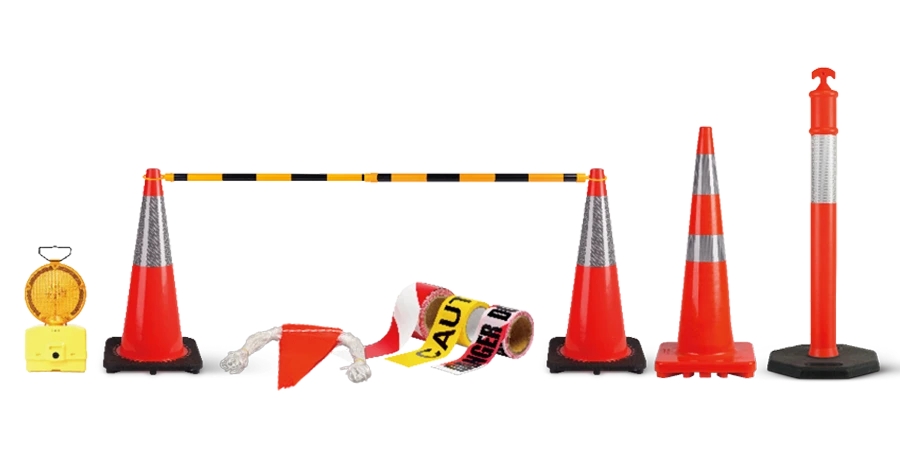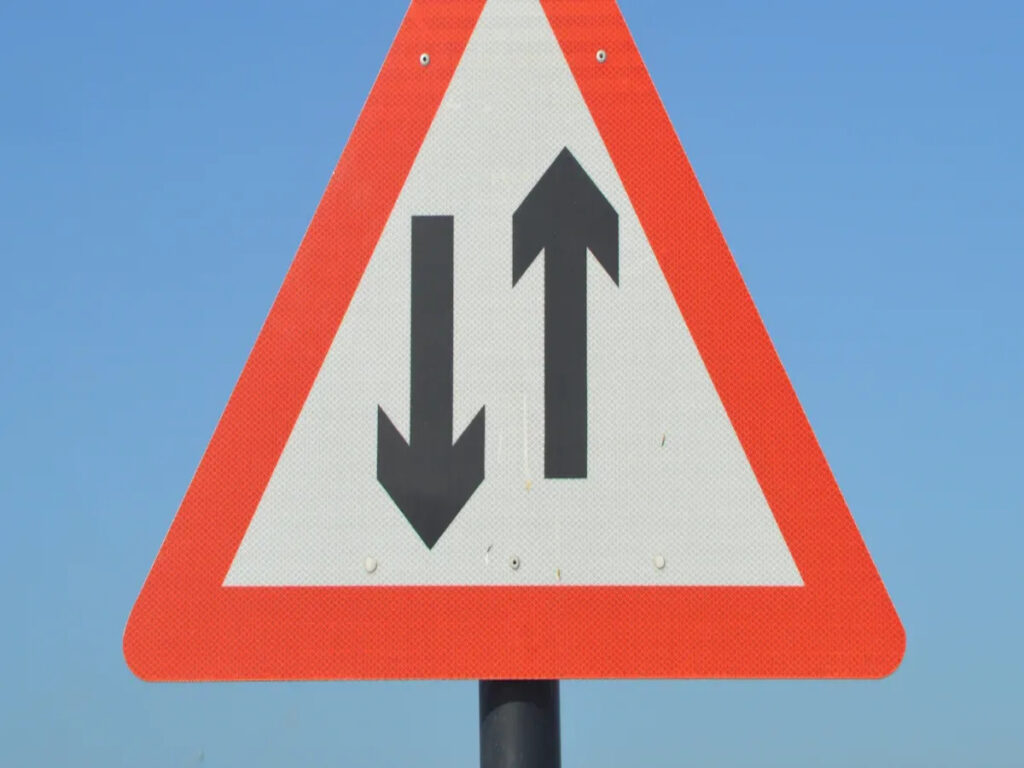
Road traffic safety signs are crucial for maintaining safe and orderly roads. These signs assist in guiding drivers, warning about potential dangers, and enforcing regulations. They play a significant role in preventing accidents. Research indicates that road traffic safety signs can reduce crashes by 52.9%, as demonstrated in a lane setup study. Innovative tools, such as LED Message Signs, enhance drivers’ ability to react quickly. Understanding how road traffic safety signs function is essential for safe and efficient driving. These signs contribute to order and enhance safety for all road users.
OPTRAFFICO is committed to improving road safety through innovation and reliability. OPTRAFFIC range of traffic safety signs is designed to support smarter traffic management and quicker driver response. With quality you can trust and products built for performance, OPTRAFFIC helps you create safer roads—every sign, ogni volta.
Let’s make traffic control simpler and safer—partner with us today.
Segni normativi: Enforcing Road Rules
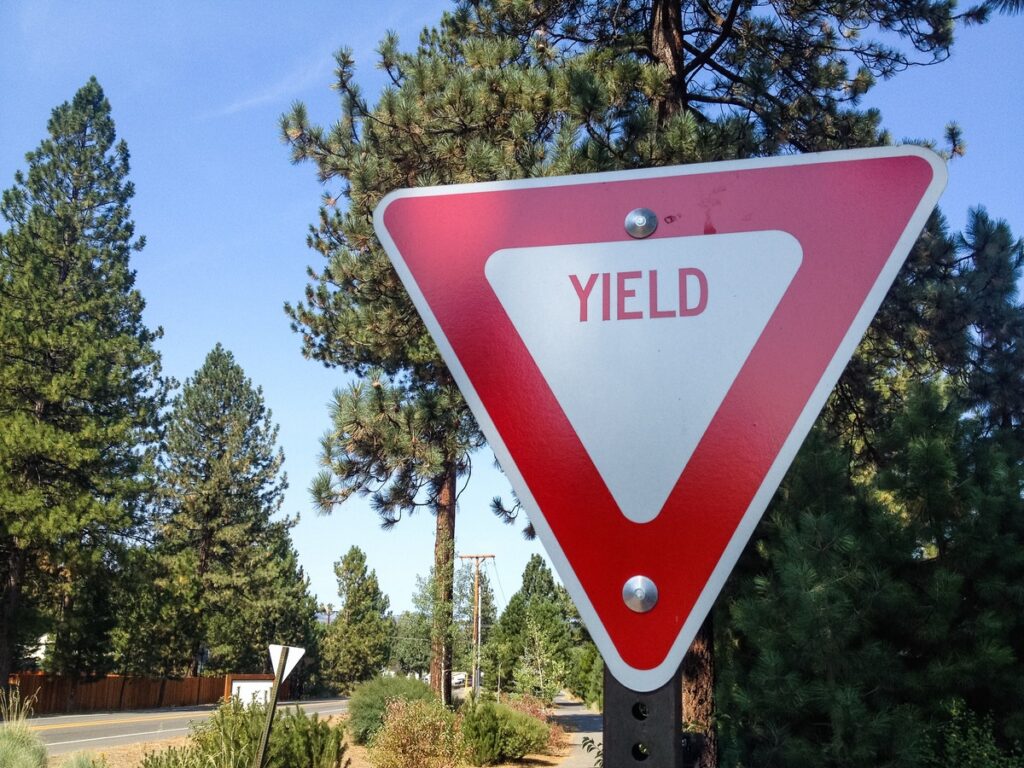
Definizione e scopo
Regulatory signs help enforce traffic rules and keep roads organized. These road traffic safety signs show laws that drivers must follow for safety. They guide drivers on what to do or avoid while driving.
You see regulatory road traffic safety signs every day, come Fermati, Prodotto, and Speed Limit signs. These road traffic safety signs help prevent crashes by controlling traffic at busy spots. A Stop sign makes cars stop fully before moving, abbassare i rischi per gli incidenti. A Yield sign helps decide who goes first, rendendo la guida più sicura. Following these signs is required by law. Ignoring them can cause accidents or lead to fines.
Design Traits
Regulatory signs are made to be easy to see and understand. Bright colors and clear symbols make them noticeable to drivers. Most have a white background with black writing or symbols, often with a red border. This design helps drivers see them, Anche al buio.
Studies show that bigger letters and thicker lines make signs easier to read, especially for older people. Flashing lights or shiny materials make them stand out more, especially in construction areas. These features ensure regulatory signs do their job—keeping drivers informed and safe.
Esempi
Common regulatory signs include Stop, Prodotto, and Speed Limit signs. Each has a specific job in controlling traffic. Stop signs make drivers stop completely to stay safe at intersections. Yield signs decide who goes first, evitare confusione e crash. Speed Limit signs remind drivers of the top speed allowed, helping traffic move smoothly and safely.
Other examples are no-entry signs, which block cars from restricted areas, e segnali di parcheggio, which control city traffic. These road traffic safety signs are placed in key spots to guide drivers and enforce rules. Seguendoli, Aiutate a rendere le strade più sicure per tutti.
Why Regulatory Signs Matter for Road Safety
Regulatory signs are essential for maintaining road safety and organization. These signs communicate clear rules that drivers must follow, reducing confusion and ensuring smooth traffic flow, Soprattutto nelle aree trafficate. Obeying these signs helps prevent accidents, rendere le strade più sicure per tutti.
Regulatory road traffic signs inform drivers of what they should or shouldn’t do. A Stop sign requires a complete stop before proceeding, preventing crashes at intersections. Yield signs indicate who should go first, Ridurre la possibilità di incidenti. Speed limit signs remind drivers to stay within safe speeds, ensuring steady traffic flow.
These signs are universally standardized, so no-entry signs prevent cars from entering restricted areas, and parking signs reduce congestion in cities. Their placement ensures drivers follow rules, promoting order.
Made with bright colors, Materiali riflettenti, e simboli chiari, these signs are designed to be visible even at night, ensuring drivers notice and follow them.
Ignoring these signs can lead to accidents or fines. By following regulatory signs, you contribute to safer roads for everyone.
Secondo il Consiglio nazionale di sicurezza (NSC), despite an increase in vehicle mileage in the first half of 2025, motor-vehicle deaths decreased by 13%, con una stima 18,720 deaths compared to 21,450 morti dentro 2024. This decrease in fatalities highlights the importance of road safety measures, such as regulatory signs, nel ridurre gli incidenti. The mileage death rate also dropped by 13.5%, further proving the positive impact of safety regulations and adherence to traffic signs in preventing accidents.
Per società di gestione del traffico and organizations responsible for road safety, these statistics underline the need for clear, durable regulatory signs to maintain safe roadways. A OPTRAFFICO, Forniamo di alta qualità, compliant traffic signs for sale designed to help enforce road safety regulations effectively. Whether you’re managing traffic in construction zones, strade urbane, o autostrade, our traffic signs ensure that your roadways are safe, organizzato, e conforme agli standard del settore. Explore our range of regulatory signs today and invest in a safer future for your community and business.
Segnali di avvertimento: Helping You Stay Safe

Quello che fanno
Warning signs let drivers know about dangers ahead. These signs grab attention and help you prepare for risks. They give time to slow down, cambiare corsia, or take action to avoid accidents.
Studies show warning signs change how drivers see and react to hazards. Per esempio, Young (1998) found that words, colori, and shapes improve how people notice dangers. Rogers et al. (2000) showed that age and education affect how drivers understand these traffic signs. This means warning signs must be easy for everyone to understand.
| Studio | Risultati |
|---|---|
| Young, 1998 | Found signal words, colori, and shapes improve hazard awareness. |
| Rogers et al., 2000 | Showed age and education affect how people understand warning signs. |
| Siu et al., 2015 | Bright signs work better for kids than plain ones. |
| Wogalter et al., 2005; Shang et al., 2015 | Explained four steps of how people process warning signs. |
| Ma et al., 2010 | Studied brain reactions to signal words on safety signs. |
How They Look
Warning signs use bright colors like yellow or orange with bold black symbols. Shapes like triangles or diamonds make them stand out and seem urgent. Research shows triangle shapes make drivers react faster than circles.
IL C-HIP model explains how people process warning signs. It includes four steps: noticing, comprensione, deciding, and acting. Clear designs help people follow these steps. Per esempio, colorful signs catch kids’ attention better than plain ones.
Esempi
Some warning signs include sharp curve, slippery road, and pedestrian crossing signs. These signs help drivers avoid danger. Per esempio:
- UN “Strada scivolosa” sign tells you to slow down on wet roads.
- UN “Passaggio pedonale” sign warns you to watch for people crossing the street.
- UN “Curva stretta avanti” sign helps you steer safely around bends.
Nuova tecnologia, like LED signs, makes warning signs even better. IL Nhtsa found roads with LED signs have fewer crashes than those with regular signs. LED signs also help drivers react faster and reduce traffic jams by showing real-time updates.
Warning signs are important for keeping roads safe. They warn drivers about dangers and help them make safer choices. Seguendo questi segnali, Aiutate a rendere la guida più sicura per tutti.
Posizionamento e visibilità
Placing warning signs in the right spots is very important. Where a sign is placed and how clear it looks help drivers react quickly. If signs are hard to see or in the wrong place, Gli incidenti possono accadere.
Warning signs should be put up far enough ahead of dangers. This gives drivers time to understand the sign and act safely. Per esempio, UN “Curva stretta avanti” sign too close to the curve doesn’t give enough time to slow down. Su strade veloci, signs need to be farther away so drivers have time to react.
Signs also need to be easy to see, anche in caso di maltempo o di notte. Studies show that bright materials make signs stand out during the day. Retroreflective materials help drivers see signs better at night or in low light.
The size and design of signs also matter. Bigger letters and thicker lines make signs easier to read from far away. Research shows drivers need at least 331 feet to see and react to a sign when driving at 55 mph. This distance helps drivers stay safe without rushing.
Adding flashing lights or special features makes signs even more noticeable. One study found that flashing signs slowed cars down twice as much as regular signs. These features are especially helpful in risky areas like construction zones or sharp turns.
| Studio | Risultati |
|---|---|
| Lyles (1981) | Flashing signs slowed cars twice as much as regular signs. |
| Somemmel (1992) | Bigger letters and lines improved reading; 331 ft needed at 55 mph. |
| Jenssen et al. (1996) | Bright materials made signs easier to see in all weather. |
| Chrysler et al. (2002) | Reflective materials helped drivers see signs better at night. |
When warning signs are placed correctly and designed well, they work better. They help drivers avoid dangers and keep roads safer for everyone. Good placement and visibility make sure signs do their job of guiding and protecting drivers.
Segni guida: Helping You Find Your Way
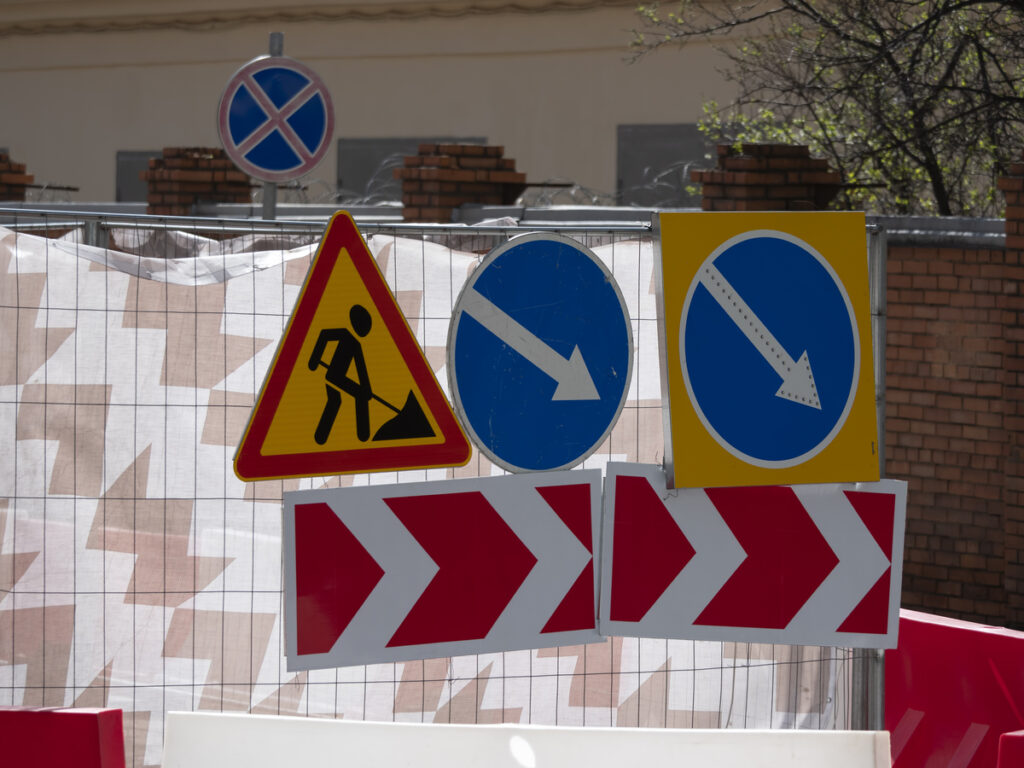
Quello che fanno
Guide signs show you where to go on the road. They work like a GPS, helping you at intersections and highways. These signs show route numbers, direzioni, and distances to places. They also give information about buses, treni, or emergency services.
Unlike rule signs, guide signs don’t tell you what to do. Invece, they use words, immagini, and arrows to help you decide. Per esempio, exit signs show where to leave the highway. They often include city names or landmarks to make it clear. These signs are very useful on tricky highway crossings.
Guide signs make driving easier and less confusing. Seguendoli, you can get to your destination safely and quickly.
How They Look
Guide signs are made to be easy to read from far away. They use colors like white letters on green or blue backgrounds. These colors are calming and help you focus on driving.
All guide signs look similar, which makes them easy to understand. This design helps you recognize them fast and know what they mean. They are placed in spots where you can see them in time to act.
Some guide signs now use LED lights to show real-time updates. These updates include lane closures or detours, helping you react faster. Studies show LED signs lower accidents by giving quick and clear information.
| Tipo di prova | Quello che mostra |
|---|---|
| Guide Signs and Arrows | Parole, immagini, and arrows help show directions. |
| Color Choices | High-contrast colors make signs easier to read from far away. |
| Consistent Design | Similar looks make navigation simpler and faster. |
| LED Signs | Real-time updates reduce crashes and improve traffic flow. |
Esempi
Common guide signs include Route signs, Destination signs, and Lane Use signs. Route signs show road numbers to keep you on the right path. Destination signs indicate how far cities or landmarks are, helping you plan your journey. Lane Use signs show which lanes to use for exits or turns.
Per esempio, a green exit sign might say, “Exit 45: Centro, 2 miles.” This tells you where to exit and how far it is. A blue hospital sign with a white “H” shows the way to medical help. These signs are strategically placed so that you have enough time to adjust your route.
An example of how guide signs work in real-time is the I-5 lane reductions project in Seattle. Between October 2025 and January 2026, the southbound lanes of I-5 across the Ship Canal Bridge will be reduced to two lanes for several weekends for maintenance and construction. Guide signs will help drivers navigate around the affected areas, ensuring smooth traffic flow even during the lane reductions.
By following these guide signs, you can drive with confidence, avoid getting lost, and plan your trips around construction or detours. These signs keep traffic moving and help you reach your destination more efficiently.
Context and Importance
Guide signs are important for helping you travel safely. Danno indicazioni chiare, making driving less confusing. These signs help traffic move smoothly and prevent delays. Whether in a city or on a highway, guide signs show the way to your destination.
One big advantage of guide signs is their clear instructions. They help you decide quickly at exits or intersections. Route signs show road numbers and directions to keep you on track. Destination signs tell how far cities or landmarks are. Lane use signs show which lanes to use for turns or exits, avoiding sudden lane changes.
| Type of Guide Sign | Quello che fa |
|---|---|
| Route signs | Show road numbers and directions for easy navigation. |
| Destination signs | Tell distances to cities, landmarks, or other places. |
| Lane Use signs | Indicate lanes for specific turns or routes. |
Guide signs make roads safer by reducing confusion. They help avoid accidents caused by wrong moves or sudden stops. These signs also guide you to bus stops, stazioni ferroviarie, o ospedali. This makes them helpful for both daily trips and long journeys.
Guide signs are made to be easy to read. Their simple design and bright colors make them noticeable, anche ad alta velocità. Some newer signs have LED displays that show real-time updates. These updates warn about traffic or detours, keeping your trip safe and smooth.
Segnali di divieto: Stopping Unsafe Actions
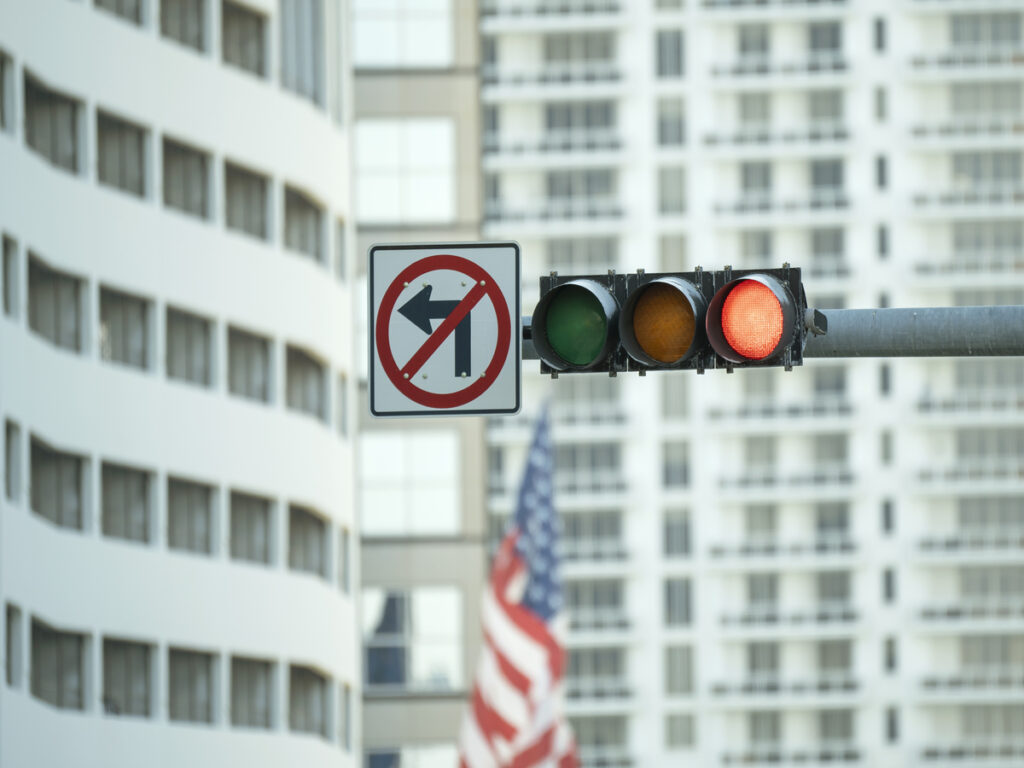
Definizione e scopo
Prohibitory signs help keep roads safe by stopping unsafe actions. These signs show what drivers must not do while driving. They are made to stop dangerous actions that might cause accidents. Per esempio, UN “Nessuna inversione a U.” sign stops risky turns in busy places.
You often see prohibitory signs in areas where safety is important. Questi includono incroci, zone scolastiche, o autostrade. These safety signs are not just advice; they are legal rules. Ignoring them can lead to fines or penalties. By following these safety signs, Aiutate a rendere le strade più sicure per tutti.
Prohibitory signs stop drivers from doing things that could cause harm.
Design Traits
Prohibitory signs are easy to spot because of their unique look. Most are round with a white background and a red border. A red slash over the symbol or words shows what is not allowed. This design helps people understand the sign quickly, even without knowing the language.
The colors and shapes are chosen to be very visible. The red border catches your eye, and the white background makes it clear. This helps the sign stand out, anche in caso di maltempo o di notte. Some newer signs use reflective materials or LED lights to be seen better in the dark.
Esempi
You see many prohibitory signs while driving. Esempi comuni includono:
- Vietato l'accesso: Stops cars from going into restricted areas.
- Parcheggio vietato: Keeps cars from blocking important spots.
- Nessuna inversione a U.: Prevents unsafe turning in certain areas.
- No Overtaking: Stops passing in places where it’s risky.
These signs are placed where they are most needed. Per esempio, UN “Parcheggio vietato” sign is near fire hydrants or hospital entrances. UN “Vietato l'accesso” sign is at one-way streets to avoid head-on crashes.
By knowing and following prohibitory signs, you help traffic move smoothly and avoid accidents. These signs are a key part of keeping roads safe for everyone.
Legal Role and Enforcement
Prohibitory signs are important for keeping roads safe and organized. These signs are actual laws that drivers must follow. They are not just advice but rules to stop accidents and keep traffic moving smoothly. Ignoring them can cause fines, penalità, or even crashes, so following them is very important.
You often see prohibitory signs in places where safety matters most. Per esempio, UN “Vietato l'accesso” sign on a one-way street stops cars from crashing head-on. UN “Parcheggio vietato” sign keeps spaces clear for emergency vehicles near hospitals or fire stations. These signs help keep order by showing what actions are not allowed.
Police and traffic officers use prohibitory signs to enforce road rules. These signs remind drivers of the laws they need to follow. They also help officers spot and handle rule-breaking easily. Ad esempio, UN “Nessuna inversione a U.” sign at a busy intersection helps officers catch unsafe turns.
Prohibitory signs are designed to be simple and clear. Their round shape, sfondo bianco, and red border make them easy to notice. A red slash over the symbol or words shows what is not allowed. This design helps drivers from anywhere understand the rules quickly.
- Prohibitory signs show traffic laws you must follow.
- They stop accidents and keep traffic flowing smoothly.
- These signs are legal rules that keep roads organized.
Prohibitory and instruction signs work together to make driving safer. Prohibitory signs tell you what not to do, while instruction signs guide you on what to do. Insieme, they help keep roads safe and well-organized for everyone.
By following prohibitory signs, you help make roads safer and more efficient. These signs are not just about avoiding fines; they protect lives and encourage responsible driving.
Segni informativi: Making Travel Easier
Quello che fanno
Informational signs give useful details to help your trip go smoothly. These signs show directions to places like hospitals, aeroporti, or tourist spots. They also help during emergencies by showing evacuation routes or where to find help. Clear and simple directions on these signs reduce confusion and help you decide quickly while driving.
These signs are important for safety too. They guide you through construction zones or warn about temporary traffic changes. Whether you’re finding a campsite or driving in a new area, these signs keep you informed and on track.
| Tipo di segno | Quello che fa |
|---|---|
| Hospital Signs | Show nearby medical centers for emergencies. |
| Campground Signs | Point to camping areas for outdoor fun. |
| Airport Signs | Lead drivers to airports for easy travel. |
| Tourist Attraction Signs | Highlight landmarks to encourage visits and exploration. |
How They Look
Informational signs are designed to be clear and easy to read. They use colors like white letters on blue or green backgrounds to stand out. Grande, bold letters make the text readable from far away. These designs help drivers understand the signs quickly.
Outdoor signs are placed where many people can see them. They are positioned so drivers notice them early enough to act. Indoor signs are placed at eye level for easy spotting. Keeping the text short and focused makes the signs simple and effective.
All informational signs look similar, which makes them easy to recognize. This familiar design helps drivers trust the signs, Anche in nuovi luoghi. Some signs use reflective materials or LED lights to be visible at night or in bad weather.
Esempi
Examples of informational signs include hospital, airport, and tourist attraction signs. A blue hospital sign with a white “H” shows where to find medical help. Airport signs guide you to terminals for smooth travel. Tourist attraction signs point out landmarks, promoting visits and local tourism.
Evacuation route signs are another example. These signs show safe exits during emergencies. Emergency service signs tell you where to find police or fire stations.
Seguendo questi segnali, you can travel confidently and without stress. Informational signs not only make trips easier but also help keep roads safe and organized for everyone.
Why Informational Signs Matter for Everyone
Informational signs are important for keeping drivers and pedestrians safe. They give clear directions to help you find places and stay safe. Whether driving in a city or walking in a new area, these signs guide you.
Per i conducenti, these signs make decisions easier and reduce confusion. Signs like hospital markers or evacuation routes show where to go in emergencies. Temporary traffic signs in construction zones guide you through detours safely. Segnaletica LED a messaggio variabile (VM) show real-time updates, like road closures or weather alerts. These updates help you react quickly and stay safe.
Pedestrians also rely on informational signs for safety and convenience. Segnali di attraversamento pedonale, bus stop markers, and tourist attraction signs make getting around easier. Nelle emergenze, evacuation route signs show safe paths to follow. Emergency service signs, like those for police or fire stations, help you find assistance when needed.
LED technology has made informational signs even better. These signs are brighter and easier to see, anche di notte. They can also change messages to show current updates, making them useful in busy areas. Studies show LED signs improve communication and help manage traffic better.
Common signs, like those for airports, ospedali, and landmarks, are simple to understand. Their similar design makes them easy to recognize, Anche in nuovi luoghi. Seguendo questi segnali, you can travel safely and avoid delays.
Informational signs help create safer and more organized roads. They guide you during daily trips and emergencies. Paying attention to these signs helps traffic flow better and keeps everyone safer.
Temporary Road Traffic Safety Signs: Handling Short-Term Road Changes
Definizione e scopo
Temporary traffic safety signs help manage short-term road changes. These safety signs guide drivers through construction, deviazioni, o emergenze. They keep you aware of sudden changes, helping you drive safely and avoid crashes.
A differenza dei segni permanenti, temporary ones are flexible and easy to adjust. They change based on conditions like road repairs or weather issues. Per esempio, UN “Road Closed Ahead” sign tells you to find another route. UN “Lane Shift” sign shows a safer way to drive. These signs protect drivers and workers by reducing confusion and marking safe areas.
Temporary safety signs also improve traffic during events or emergencies. They give real-time updates so you can quickly change your route. Seguendo questi segnali, Aiutate a rendere le strade più sicure per tutti.
Design Traits
Temporary traffic signs are made to be bright and easy to see. Colors like orange or yellow catch your eye, and bold black text gives clear instructions. Reflective materials or flashing lights make them visible at night or in bad weather.
These road traffic safety signs are lightweight and easy to move. Some are placed on stands or barricades, while others are attached to vehicles. Segni di messaggio mutevoli (CMS) show real-time updates, like lane closures or speed changes. Arrow panels and warning flags make them even easier to notice, guiding you safely through work zones.
Extra safety features like rumble strips and alarms add protection. Rumble strips make noise and vibrations to warn you of hazards. Intrusion alarms alert workers if a car enters a restricted area. These features keep both drivers and workers safe.
| Caratteristica | Scopo |
|---|---|
| Materiali riflettenti | Helps drivers see signs in low light or at night. |
| Segni di messaggio mutevoli (CMS) | Shows real-time updates about road changes. |
| Arrow panels | Guides traffic around work zones safely. |
| Avviso bandiere e luci | Makes hazards more noticeable to drivers. |
| Rumble strips | Warns drivers with sound and vibrations. |
| Intrusion alarms | Alerts workers if cars enter unsafe areas. |
Esempi
Temporary traffic signs come in different types for various situations. Esempi comuni includono:
- Road Closed Ahead: Tells you to take a different route.
- Lane Shift: Shows a temporary change in lane direction.
- Lavori in corso: Warns about construction ahead.
- Deviazione: Points you to a safe alternate path.
Segni di messaggio mutevoli are very effective in preventing accidents. Studies show these signs reduce lane use by 46% durante le chiusure. Fewer cars stay in closed lanes when CMS messages are used, rendere le strade più sicure.
Fluorescent signs work better than regular ones in work zones. Per esempio:
- Traffic problems dropped by 11.1% con insegne fluorescenti.
- Sopra 100 fewer cars stayed in closed lanes during closures.
- Trucks left restricted lanes 30% more often than expected.
Temporary traffic signs are crucial for handling short-term road changes. They keep you informed, guide you safely, e proteggere i lavoratori. Paying attention to these signs helps make roads safer and more efficient.
Why Temporary Signs Matter in Work Zones and Emergencies
Temporary traffic signs are very important in work zones and emergencies. They keep workers and drivers safe by showing dangers and guiding traffic. These road traffic safety signs help you handle sudden road changes, keeping everyone protected.
Nelle zone di lavoro, these road traffic safety signs warn about construction and new traffic patterns. Per esempio, UN “Lane ha chiuso in anticipo” sign tells you to merge safely. Without these road traffic safety signs, confusion could cause crashes or slowdowns. Workers depend on them to stay safe while fixing roads or building new ones.
Mancia: Slow down and stay focused when you see temporary signs. This helps protect both you and the workers.
Emergencies like storms or accidents also need temporary signs. These signs give important directions during chaotic times. Ad esempio, an “Evacuation Route” sign shows the safest way to leave. UN “Deviazione” sign helps you avoid blocked roads and stay safe.
Bright colors and flashing lights make emergency signs easy to notice. Reflective materials help you see them at night, so you can follow them anytime.
Benefits of Temporary Signs in Work Zones and Emergencies
- Miglioramento della sicurezza: These signs lower accident risks by guiding you through tricky areas.
- Simple Directions: They give clear instructions to help you act quickly.
- Migliore flusso di traffico: Signs manage vehicles to avoid jams and delays.
- Sicurezza dei lavoratori: Segni come “Lavori in corso” remind you to drive carefully near workers.
| Situazione | Segno di esempio | Quello che fa |
|---|---|---|
| Construction Zone | “Lane Shift” | Helps you follow new traffic patterns. |
| Accident Scene | “Road Closed Ahead” | Guides you to a safer path. |
| Natural Disaster | “Evacuation Route” | Points to the safest way out. |
Temporary traffic signs are crucial for keeping order during disruptions. Seguendo questi segnali, you help make roads safer and smoother. Always pay attention and follow their instructions to protect yourself and others.
Tabella di confronto: Quick Guide to Road Traffic Safety Signs
Key Features and Examples
The table below shows the main features and examples of each type. Use it to quickly understand what traffic signs mean and how they look.
| Categoria | Scopo | Color/Shape | Esempi | Luoghi comuni |
|---|---|---|---|---|
| Normativo | Show traffic rules | Sfondo bianco, red/black text | Fermare, Prodotto, Limite di velocità | Incroci, autostrade |
| Avvertimento | Avvertire i pericoli | Yellow/Orange, triangle/diamond | Strada scivolosa, Curva stretta | Before hazards, zone di lavoro |
| Guida | Help with directions | Green/Blue background, rettangolo | Exit Signs, Route Numbers | Autostrade, Strade della città |
| Proibitivo | Stop unsafe actions | Sfondo bianco, bordo rosso | Nessuna inversione a U., Parcheggio vietato | Aree urbane, zone scolastiche |
| Informational | Give useful details | Blue/Green background, rettangolo | Hospital, Tourist Attraction | Tourist spots, percorsi di emergenza |
Mancia: Look at the colors and shapes of road traffic safety signs. These clues help you understand their meaning quickly, Anche da lontano.
By learning these features, you can travel more safely and confidently. Traffic signs are made to share important information clearly. Whether you’re driving, ciclismo, or walking, knowing these signs makes the journey safer for everyone.
Traffic signs are very important for keeping roads safe and orderly. There are five main types of traffic signs: normativo, avvertimento, guida, prohibitory, e segni informativi. Each type has a special job to help drivers. These road traffic safety signs show rules, Avvertire i pericoli, and guide you where to go. Knowing these types of signs helps prevent accidents and keeps roads safer. Paying attention to traffic signs makes travel easier and safer for everyone.
Understanding traffic signs helps you drive safely and protect others.
Domande frequenti
What are the five categories of traffic safety signs?
Traffic safety signs are categorized into Segni normativi, Segnali di avvertimento, segnali guida, prohibitory signs, E segni temporanei. Each category serves a distinct purpose:
- Segni normativi inform drivers of traffic laws they must follow.
- Segnali di avvertimento alert drivers to potential hazards.
- Segni guida provide directional information and assist in navigation.
- Prohibitory signs indicate actions that are not allowed, such as U-turns or parking restrictions.
- Segni temporanei manage short-term changes, like roadwork or detours.
For high-quality signs from each category, OPTRAFFICO provides reliable, durable options designed for safety and compliance. Explore our range to ensure your traffic management is top-notch.
How can you spot a warning sign?
Warning signs are typically bright yellow or orange with black symbols or text and are often shaped like triangles or diamonds. These signs are designed to alert drivers to potential hazards such as sharp turns, wet roads, o zone di costruzione. For industries like construction, where workers and drivers are exposed to frequent hazards, having clear and visible warning signs is crucial. OPTRAFFIC offers high-visibility warning signs that help ensure safety on construction sites, preventing accidents and improving awareness of risks.
Why are regulatory signs needed?
Regulatory signs inform road users of essential traffic laws and regulations, such as stop, prodotto, o limiti di velocità. These signs are vital for maintaining order and ensuring safety on the roads, especially in busy urban areas or construction zones. For companies managing traffic in construction zones, having properly placed regulatory signs helps ensure smooth traffic flow and prevents fines or accidents. OPTRAFFIC offers a wide range of regulatory traffic signs that meet local and national standards, ensuring compliance and promoting safety in high-risk areas.
Where do you see guide signs?
Guide signs are found on highways, All'intersezione, and along city streets. They provide crucial directional information, distanze, and landmark identification. For businesses involved in event management, municipal planning, o costruzione, guide signs are essential for helping drivers and pedestrians navigate safely through complex roadways or temporary setups.
What makes prohibitory signs special?
Prohibitory signs feature a red border and a slash over symbols, indicating actions that are not allowed, such as U-turns, parking restrictions, o limiti di velocità. These signs are critical for enforcing legal traffic rules, especially in areas with high foot traffic or construction zones where safety is paramount.
How are temporary signs different from permanent ones?
Temporary signs are used to manage short-term changes, such as roadwork, deviazioni, o emergenze. They are typically bright, facile da spostare, and provide real-time guidance to drivers. Whether you need signs for construction zones or temporary traffic control, OPTRAFFICO provides durable temporary traffic signs designed for flexibility and safety.
Do informational signs make travel easier?
SÌ, informational signs give details about hospitals, aeroporti, or landmarks. They help you avoid confusion and make traveling simpler, Soprattutto in nuovi luoghi.
How do I choose the right traffic signs for my workplace or construction site?
Choosing the right traffic signs depends on your specific needs. If you’re managing a construction site, you’ll need a combination of warning signs to alert workers to hazards, regulatory signs to ensure compliance, and temporary signs to guide traffic around work zones. OPTRAFFIC offers a wide selection of traffic signs for all environments, ensuring that your workplace or site is equipped with the proper safety signage. Browse our collection to find the best solutions for your needs.
How can I purchase high-quality traffic signs for my project?
OPTRAFFICO makes it easy to purchase high-quality, durable traffic signs for any project. Se hai bisogno Segni normativi, Segnali di avvertimento, O segni temporanei, we offer a wide range of options that meet industry standards. Shop online now for fast delivery and expert customer service to ensure your traffic safety needs are met efficiently.
